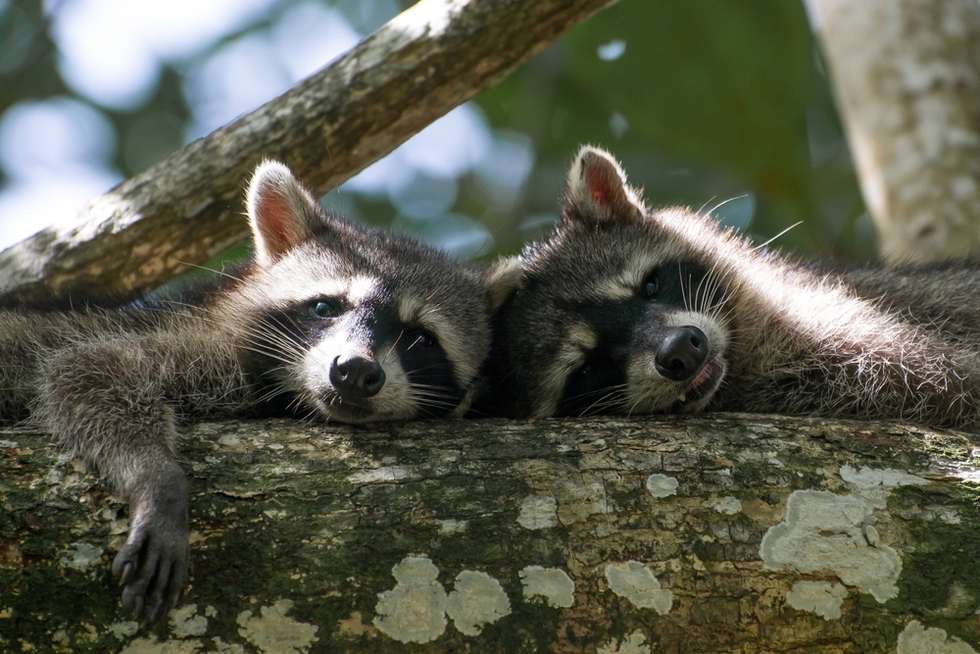Exploring Cahuita National Park
This little gem of a national park sits at the southern edge of Cahuita. Although the pristine white-sand beach, with its picture-perfect line of coconut palms and lush coastal forest backing it, is the main draw here, the park was actually created to preserve the 240-hectare (787-acre) coral reef just offshore. The reef contains 35 species of coral and provides a haven for hundreds of brightly colored tropical fish. You can walk on the beach itself or follow the trail that runs through the forest just behind the beach.
One of the best places to swim is just before or beyond the Río Perezoso (Lazy River), several hundred meters inside Cahuita National Park. The trail behind the beach is great for bird-watching, and you might see a sloth or some howler or white-faced monkeys. Nearer at hand, you’re likely to hear crabs and lizards scuttling in the dry leaves on the forest floor. A half-dozen or so species of land crabs live in this region, including some that are a beautiful bright orange and purple. The trail behind the beach is great for bird-watching, and you might see a sloth or some howler or white-faced monkeys. Nearer at hand, you’re likely to hear crabs and lizards scuttling in the dry leaves on the forest floor. A half-dozen or so species of land crabs live in this region, including some that are a beautiful bright orange and purple.
The trail behind the beach stretches a little more than 9km (5.6 miles) to the southern end of the park at Puerto Vargas (tel. 2755-0302), where you’ll find a beautiful white-sand beach. The best section of reef is off the point at Punta Cahuita, and you can snorkel here if accompanied by a local guide. If you don’t dawdle, the 3.8km (2.4-mile) hike to Punta Cahuita should take a little over an hour each way—although I’d allow plenty of extra time to enjoy the flora and fauna, and take a dip or two in the sea. Bring plenty of mosquito repellent because this area can be buggy.
Although you can snorkel from the shore at Punta Cahuita, it’s best to have a boat take you out to the nicest coral heads just offshore. A 3-hour snorkel trip costs between $25 and $40 per person, with equipment. You can arrange one with any of the local tour companies listed. Note: These trips are best taken when the seas are calm—for safety’s sake, visibility, and comfort.
One great way to explore Cahuita National Park is to pack a picnic lunch and snorkel gear and hire a guide in the town of Cahuita. You’re not supposed to snorkel here without a local guide, and you’ll see a lot more animals with a guide’s expert eye. You can then hike the rainforest trail to Punta Cahuita, where you can snorkel the reef, swim in the tide pools, and have lunch. (But don’t ever leave valuables unattended on the beach—any beach.) After that you can return the way you came, if you have a car in Cahuita, or even better, continue on to Puerto Vargas and catch a bus or taxi from there. For most of this hike, you can choose between the shaded jungle trail or the sunny beach, stopping for a cooling dip when the mood strikes.
Entry Points, Fees & Regulations
The in-town park entrance is just over a footbridge at the end of the village’s main street. It has restroom facilities, changing rooms, and storage lockers. This is the best place to enter for a day hike and some beach time.
The alternate park entrance is at the southern end of the park in Puerto Vargas. This is where you should come if you don’t feel up to hiking a couple of hours to reach the good snorkeling spots. The road to Puerto Vargas is approximately 5km (3 miles) south of Cahuita.
There's no admission fee to enter the park, but donations are suggested. The park is open from dawn to dusk for day visitors.
Getting There
By Car: The turnoff for the Puerto Vargas entrance is clearly marked 5km (3 miles) south of Cahuita.
By Bus: Your best bet is to get off a Puerto Viejo- or Sixaola-bound bus at the turnoff for the Puerto Vargas entrance (well-marked, but tell the bus driver in advance). The guard station/entrance is about 500m (1,640 ft.) down this road. However, the beach and trails are several kilometers farther.
You Can Bring It with You
I recommend packing a picnic lunch, plenty of water, and some snorkel gear and hiking out along the inland rainforest trail, all the way out to Punta Cahuita. Once there, you can spread out a blanket or some towels, snorkel on the reef, and swim in the tide pools, before enjoying your lunch. You can walk along the beach for most of the return trip to town, and stop for a cooling dip or two if the mood strikes.
Damaged & Endangered
While patches of living, vibrant reef survive off Costa Rica's Caribbean coast, much of it has been killed off, or is severely threatened by over-fishing, pollution, rain, and mud runoff during the rainy season. Much of the damage can be traced to the massive banana plantations that line this coastline, which have had a direct role in increasing the amount of muddy runoff and have dumped tons of plastic and pesticides into the fragile, inshore reef systems.
Note: This information was accurate when it was published, but can change without notice. Please be sure to confirm all rates and details directly with the companies in question before planning your trip.









